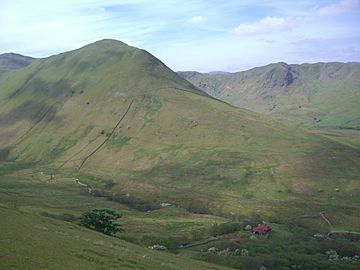The Nab facts for kids
Quick facts for kids The Nab |
|
|---|---|

Seen from Martindale on the lower slopes of Wether Hill. "The Bungalow" is visible in the valley.
|
|
| Highest point | |
| Elevation | 576 m (1,890 ft) |
| Prominence | 61 m (200 ft) |
| Parent peak | Rest Dodd |
| Listing | Wainwright |
| Geography | |
| Location | Cumbria, England |
| Parent range | Lake District, Far Eastern Fells |
| OS grid | NY434152 |
| Topo map | OS Explorer OL5 |

The Nab is a mountain, known as a "fell," located in the beautiful Lake District in England. It stands at a height of 576 meters (about 1,890 feet). You can find it in the quieter eastern part of the Lake District, nestled between two lakes: Ullswater and Haweswater Reservoir.
The Nab is special because it's included in Alfred Wainwright's famous list of Lakeland fells. Many hikers like to climb it to complete their collection of "Wainwrights," even though it's not one of the most famous or easiest fells to reach.
Contents
About The Nab's Shape and Land
The Nab is part of a longer ridge that extends north from a larger fell called Rest Dodd. This ridge helps to divide two valleys, Bannerdale and Rampsgill. These valleys meet up below the very front of The Nab's ridge, forming a stream called How Grain.
The sides of The Nab's ridge are quite steep and rugged. However, the very top of the fell is wide and flat. You might notice some deep holes on the top, which are called peat hags. These are areas where the ground is made of old, decayed plant material, and some can be deeper than a person is tall!
Exploring The Nab: History and Access
For a long time, The Nab was not open to the public. When the famous fell-walker Alfred Wainwright wrote his guidebooks in the 1950s, The Nab was part of a private deer forest in Martindale. He even wrote that "Keep Out" signs and barbed wire made it clear that walkers were not welcome.
Things have changed a lot since then! Now, The Nab is mostly open for people to explore, thanks to a law called the Countryside and Rights of Way Act 2000. You might still see some "Private" signs, but the old barbed wire and barriers are gone. Walkers are generally allowed, except sometimes during the deer hunting season. It's still a good idea to check with the Dalemain Estate (who own the land) in Pooley Bridge if you plan to visit, just to be sure.
The Bungalow and Red Deer
If you approach The Nab from the north, you'll see a building called 'The Bungalow' in Martindale. This building was built in 1910 as a special hunting lodge for the Earl of Lonsdale. It was even used by Kaiser Wilhelm when he visited! Today, it's a holiday cottage that people can rent.
The area around The Nab is also home to a special group of Red deer. A report from the government found that the deer in Martindale might be the only pure-blooded Red Deer left in England. This is because many other herds have mixed with genes from another type of deer called the Sika deer.
Reaching The Nab's Summit
The very top of The Nab is a grassy, rounded area marked by a small pile of stones called a cairn. From the summit, you can't see much to the south because of higher ground. However, you get a great view all the way along the Helvellyn range and towards Angletarn Pikes.
Paths to the Top
One way to reach the summit from Martindale is by following a well-made path that zig-zags up the fell. This path was built for deer stalkers (people who track deer) and helps walkers avoid any difficult rocky areas just below the summit.
Many walkers who climb The Nab choose a different route to avoid disturbing the Dalemain Estate. They approach the summit by walking along the ridge that connects The Nab to the nearby fell of Rest Dodd. This path can be a bit boggy (wet and soft), but it offers a wonderful chance to see herds of Red deer roaming freely on the open fell.
A great starting point for this popular route is the village of Hartsop in Patterdale. There's a large car park there, and Hartsop is just off the A592 main road. This circular walk is a good option because it also lets you visit other "Wainwright fells" like Brock Crags, Rest Dodd, and Angletarn Pikes before you head back down to Hartsop.


